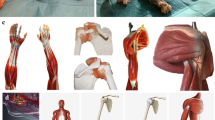Abstract
Little attention has been given to structured teaching of applied anatomy to senior medical students in problem-based learning (PBL) medical schools. A course named “Anatomical Principles in Surgical Practice” was introduced at the Arabian Gulf University (AGU) in 2001 for fifth- and sixth-year medical students during their surgical clerkship rotation. The course aims to emphasize, update and integrate applied anatomical concepts that are essential for surgical practice. The course consists of 15 interactive sessions held weekly to ensure topics coincide with the surgical problem-solving sessions. A questionnaire was administered to students completing their surgical rotations (n=131) seeking their perceptions about the new course during the academic years 2001, 2002 and 2003. To measure learning outcome, 70 students were also given pre- and post-tests. Positive responses were given by 85.2% of the students for course arrangement, by 92.0% for course content, by 88.3% for clinical correlation, by 95.2% for level of teaching and by 87.2% for overall judgment. The students’ mean scores in the post-test (71.7%±11.7) was significantly higher than their mean scores in the pre-test (42.3%±12.6, p<0.001). Students liked the course and reported feeling more confident in correlating anatomy with surgery during their rotations. By extending anatomical teaching into the clerkship phase, a link between basic medical and clinical sciences has been established that further enhances vertical integration within a PBL curriculum in a spiral fashion.

Similar content being viewed by others
References
Abu-Hijleh MF, Habbal OA, Moqattash ST, Harris PF (1995) Clinical anatomy and anatomical skills: an innovative course. Med Teacher 17:283–288
Abu-Hijleh MF, Kassab S, Al-Shboul Q, Ganguly PK (2004) Evaluation of the teaching strategy of cardiovascular system in a problem-based curriculum: student perception. Adv Physiol Educ 28:59–63
Albanese MA, Mitchell S (1993) Problem-based learning: a review of literature on its outcomes and implementation issues. Acad Med 68:52–81
Bandaranayake R (1979) Who wants to teach anatomy? Med J Aust 1:606–607
Boon JM, Meiring JH, Richards PA (2002) Clinical anatomy as the basis for clinical examination: development and evaluation of an Introduction to Clinical Examination in a problem-oriented medical curriculum. Clin Anat 15:45–50
Dinsmore CE, Paul HA, Sweet FA (1993) A course of study in the anatomical sciences for a problem-based curriculum. Clin Anat 6:240–246
Ganguly KP, Chakravarty M, A-Latif N, Osman M, Abu-Hijleh M (2003) Teaching of anatomy in a problem-based curriculum at the Arabian Gulf University: the new face of the museum. Clin Anat 16:256–261
General Medical Council (1993) Tomorrow’s doctors: recommendations on undergraduate medical education. General Medical Council, London
Hamdy H, Williams R, Tekian A, Benjamin S, El Shazali H, Bandaranayake R (2001) Applications of “VITALS,” Visual Indicators of Teaching and Learning Success, in reporting student evaluation of clinical teachers. Educ Health 14:267–276
Hamdy H, Greally M, Grant IN, El-Shazali H, Nayar U, Rajab K, Al-Roomi K, Mohammad AM, Hamza A-A, Al-Awadhi MA, Al-Refai AM (2001) Professional skills programme in a problem-based learning curriculum: experience at the College of Medicine & Medical Sciences, Arabian Gulf University. Med Teacher 23:223–225
Harris PF, Abu-Hijleh MF, Moqattash S (1994) Teaching anatomy in the Middle East: opportunities and challenges at a new medical school. Clin Anat 7:152–155
Heylings DJA (2002) Anatomy 1999–2000: the curriculum, who teaches it and how? Med Educ 36:702–710
Maudsley G (1999) Do we all mean the same thing by “problem-based learning”? A review of the concepts and a formulation of the ground-rules. Acad Med 74:78–85
Pallie W, Carr DH (1987) The McMaster medical education philosophy in theory, practice and historical perspective. Med Teacher 9:59–71
Prince KJAH, van Mameren H, Hylkema N, Drukker J, Scherpbier AJJA, van der Vleuten CPM (2003) Does problem-based learning lead to deficiencies in basic science knowledge? An empirical case on anatomy. Med Educ 37:15–21
Report from the World Federation for Medical Education (2000) WFME Task Force on Defining International Standards in Basic Medical Education. Med Educ 34:665–675
Schmidt HG (1993) Foundations of problem-based learning: some explanatory notes. Med Educ 27:422–432
Tekian A, Williams R (1997) Visual Indicators of Teaching and Learning Success (VITALS): stakeholders’ perceptions of a course improvement system. Acad Med 72:412–416
Travill AA (1977) The anatomical basis of clinical practice: an anatomy-learning programme. Med Educ 11:377–379
Vidic B, Weitlauf HM (2002) Horizontal and vertical integration of academic disciplines in the medical school curriculum. Clin Anat 15:233–235
Walton HJ, Matthews MB (1989) Essentials of problem-based learning. Med Educ 23:542–558
Acknowledgements
The authors are grateful to Ms. Brownell Anderson, Visiting Faculty in the Master of Health Profession Education Program, for her valuable comments and encouragement, and also to the students who participated in this study by providing feedback on their learning experience.
Author information
Authors and Affiliations
Corresponding author
Rights and permissions
About this article
Cite this article
Abu-Hijleh, M.F., Chakravarty, M., Al-Shboul, Q. et al. Integrating applied anatomy in surgical clerkship in a problem-based learning curriculum. Surg Radiol Anat 27, 152–157 (2005). https://doi.org/10.1007/s00276-004-0293-4
Received:
Accepted:
Published:
Issue Date:
DOI: https://doi.org/10.1007/s00276-004-0293-4




